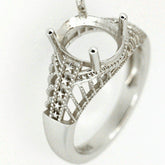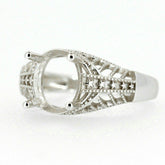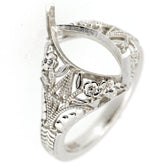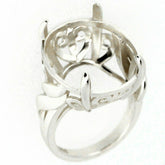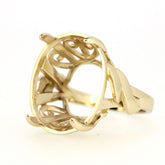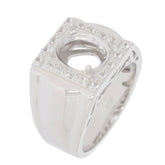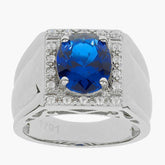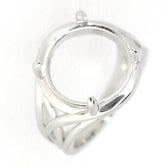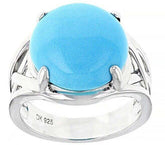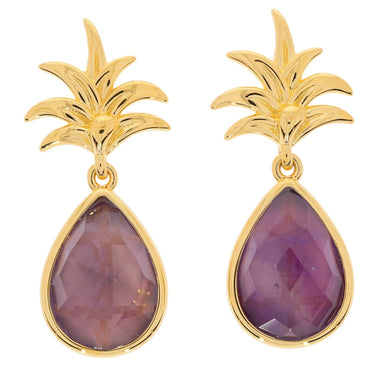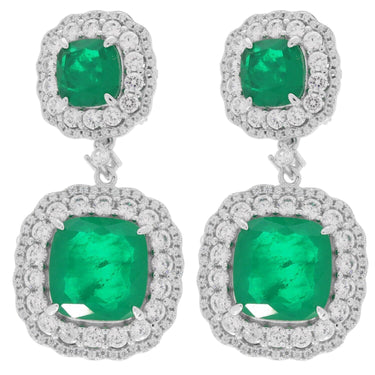Como Identificar Joias Art Déco e Art Nouveau: Um Guia Prático
No dinâmico mundo da estética da joalharia, diferenciar entre joias Art Deco e Art Nouveau é essencial para qualquer colecionador ou entusiasta. Este guia de estilos de joalharia serve tanto como um tratado académico como um manual prático, capacitando-o a reconhecer as distinções subtis nos elementos de design, materialidade e contexto histórico. Se procura dominar as configurações de anéis art deco, aprofundar a sua compreensão da estética da joalharia ou explorar o mundo em evolução das configurações de anéis art deco da Syzjewelry, este guia abrangente iluminará as estratégias mais autoritativas para uma identificação confiante.
Índice
- A Essência do Art Deco e do Art Nouveau
- Características Identificativas da Joalharia Art Nouveau
- Características Distintivas da Joalharia Art Deco
- Escolhas de Materiais no Art Deco vs Art Nouveau
- Paletas de Cor e o Seu Simbolismo
- Reconhecendo Peças Autênticas: Dicas e Truques
- A Popularidade Duradoura do Art Déco e do Art Nouveau
- Comprar Joias Art Déco e Art Nouveau
- Cuidados e Manutenção de Joias Art Déco e Art Nouveau
- Conclusão: A Beleza dos Estilos de Joalharia Intemporais
A Essência do Art Deco e do Art Nouveau

Uma Breve História do Art Nouveau
O Art Nouveau surgiu por volta de 1890, desenvolvendo-se até à Primeira Guerra Mundial. A sua formação refletiu respostas únicas à ansiedade do final do século XIX em relação à imitação histórica e à crescente uniformidade industrial. Inspirando-se no movimento britânico Arts and Crafts, no Esteticismo e no Japonismo, o Art Nouveau defendia uma visão artística unificada através dos meios, procurando a harmonia entre as artes aplicadas e as belas-artes. Caracterizado por curvas pronunciadas em forma de chicote e motivos orgânicos, as suas interpretações em joalharia incorporavam linhas fluidas e femininas que celebram a beleza natural. Motivos proeminentes incluem lírios, íris, libélulas e figuras femininas — símbolos de vitalidade e transformação. Paletas de cores suaves e apagadas reforçam a coesão temática que distinguiu a abordagem do Art Nouveau ao longo da era moderna inicial.
Uma Breve História do Art Deco
O Art Deco ascendeu na sequência do Art Nouveau, cristalizando a sua identidade na década de 1920 e estendendo-se até aos anos 1930 — um período definido pelos efeitos e aspirações da modernidade pós-guerra. Impulsionado pelos avanços na engenharia e pelo otimismo social, o movimento Art Deco defendeu a nova paisagem urbana, ecoando as silhuetas aerodinâmicas dos arranha-céus e o dinamismo tecnológico nos seus motivos angulares. Abraçando a simetria, esquemas cromáticos ousados e clareza geométrica, a joalharia Art Deco significava luxo cosmopolita e progresso. Arquitetos e artistas decorativos inspiraram-se em culturas globais, diversificando ainda mais a paleta e a ornamentação do estilo. Desde raios de sol estilizados a zigurates, o Art Deco expressava uma fascinação pela velocidade, inovação e pela máquina.
Visão Comparativa do Art Deco e do Art Nouveau
Embora ambos os movimentos procurassem redefinir os limites estéticos, as suas prioridades artísticas divergem fundamentalmente: a joalharia Art Nouveau celebrava a sensualidade da forma, privilegiando formas fluidas derivadas da natureza e uma gama de cores suave e harmoniosa; o Art Deco, pelo contrário, elevava a abstração e a ousadia, combinando geometria nítida com tons vivos e contrastantes. As seleções de materiais e as técnicas de fabrico diferenciam ainda mais os estilos. O Art Nouveau empregava frequentemente materiais não tradicionais (marfim, chifre, esmalte) e artesanato virtuoso, enquanto o Art Deco preferia processos industriais e substâncias de alto valor, como platina e diamantes. A narrativa subjacente a cada movimento é distinta: o Art Nouveau olhava para trás, romantizando o orgânico, enquanto o Art Deco olhava para a frente, (por vezes literalmente) refletindo o brilho da modernidade tanto na pedra como no metal.
Características Identificativas da Joalharia Art Nouveau

Elementos de Design: Curvas, Motivos Florais e Linhas em Chicote
A joalharia Art Nouveau é instantaneamente reconhecível pelas suas formas orgânicas e pelas suas linhas assimétricas fluídas características. Abraçando a vitalidade e a imprevisibilidade da natureza, estas peças empregam curvas ondulantes, estruturas elegantemente dinâmicas em forma de chicote e motivos florais exuberantes. Lírios, íris e orquídeas, representados com modelação requintada, dominam este género, frequentemente entrelaçados em padrões intrincados. Formas animais — especialmente libélulas, borboletas e pavões — acrescentam profundidade simbólica, ligando os utilizadores a noções de transformação e ciclos naturais. Os colecionadores frequentemente maravilham-se com a forma como estes elementos se entrelaçam para criar uma peça que parece mover-se mesmo em repouso.
Materiais Comumente Usados na Joalharia Art Nouveau
Pioneira na sua abordagem à materialidade, a Art Nouveau abraçou tanto o precioso como o inesperado. Os artesãos usaram ouro e prata, mas também celebraram o esmalte (notadamente técnicas piqué-à-jour), conferindo luminosidade e cor reminiscentes do vitral. Materiais naturais—marfim, chifre, madrepérola e tartaruga—amplificaram a ligação tátil e visual à vida orgânica. Pedras preciosas como opalas e pedras da lua eram valorizadas pelo seu brilho interior, realçando a estética da joalharia com efeitos etéreos e captadores de luz. Esta integração inovadora de materiais díspares refletia a filosofia do movimento de que o artesanato e a arte deveriam elevar cada peça para além do valor ornamental.
Exemplos de Peças de Joalharia Art Nouveau
As obras-primas da joalharia Art Nouveau são verdadeiras esculturas em miniatura. Tome-se, por exemplo, os colares delicadamente trabalhados por René Lalique, cujas evocações de folhagem e mulheres míticas estabeleceram novos padrões para a ambição criativa. Broches com insetos incrustados de gemas pousados em pétalas ilustram tanto habilidade técnica excecional como simbolismo narrativo. Pedras como a pedra da lua e opalas, combinadas com esmaltação requintada, deram origem a pendentes luminosos imbuídos de um inconfundível sentido de feminilidade e poesia da natureza. O uso audacioso de formas orgânicas por Lucien Gautrait ultrapassou limites, consolidando a sua reputação como líder na história dos guias de estilo da joalharia. Cada peça autêntica é uma celebração—não só da estética da sua época, mas também da pura força imaginativa.
Características Distintivas da Joalharia Art Deco

Formas Geométricas e Linhas Limpas
A marca da joalharia Art Deco é a sua impressionante adoção da geometria e da ordem. Padrões angulares—retângulos, triângulos, chevrons, raios solares—são organizados com rigorosa regularidade. Os ecos arquitetónicos são inconfundíveis, referenciando horizontes modernos e progresso industrial. Linhas limpas, simetria e um equilíbrio quase matemático permeiam tudo, desde pulseiras a engastes de anéis art deco. Se estiver a analisar engastes de anéis Syzjewelry art deco ou broches clássicos Deco, repare na calibração precisa das proporções e motivos que definem cada exemplo.
Materiais e Técnicas na Joalharia Art Deco
O Art Deco inaugurou uma revolução na estética da joalharia, especialmente com a sua adoção de materiais de alto contraste. Platina e ouro branco tornaram-se as escolhas preferidas para engastes, especialmente para diamantes—frequentemente em cortes inovadores como Asscher e formas de esmeralda. Pedras preciosas coloridas—rubis, esmeraldas, safiras—foram integradas com um estilo gráfico, organizadas usando técnicas especializadas (incluindo cortes calibre e engastes invisíveis). A busca deste período pela clareza gráfica e refração da luz gerou obras deslumbrantes, com metal mínimo visível e pedras formando mosaicos vívidos e estruturados. A atenção à perfeição mecânica e execução luxuosa significava que mesmo peças produzidas em massa mantinham um forte sentido de exclusividade.
Exemplos Notáveis de Joalharia Art Deco
Os colares “Tutti Frutti” da Cartier exemplificam a sinergia entre rigor geométrico e cor vibrante. O “Mystery Set” da Van Cleef & Arpels—pedras configuradas com quase nenhum metal visível—exibe uma ousadia técnica única da época. As configurações de anéis art deco, especialmente as da Syzjewelry, refletem esta herança estilística através de pedras centrais arrojadas rodeadas por gemas de realce meticulosamente cortadas em arranjos simétricos. A joalharia conversível, com segmentos desenhados para se destacarem para uso multifuncional, e a inclusão de motivos lúdicos como franjas, demonstram a aceitação do Art Deco pela vida moderna e engenho.
Escolhas de Materiais no Art Deco vs Art Nouveau

Tendências de Pedras Preciosas em Ambos os Estilos
A estética da joalharia Art Nouveau valorizava as pedras preciosas pela sua beleza individual e compatibilidade com motivos orgânicos, favorecendo opalas, granadas e pérolas pela sua opacidade e cor matizada. Em vez de maximizar o brilho, estas pedras apoiavam a narrativa e o fluxo visual da peça. Em contraste, a joalharia Art Deco fez dos diamantes o seu ícone—brilhando nas configurações de anéis art deco—e elevou safiras, rubis e esmeraldas através de técnicas desenhadas para maximizar o brilho e o efeito geométrico. Pedras coloridas exóticas e a introdução de gemas produzidas em laboratório também sinalizaram uma vontade de inovar, refletindo como o guia de estilos de joalharia de cada período reflete valores sociais mais amplos.
Preferências Metálicas: Ouro, Prata e Além
O ouro e a prata maleáveis, dourados e frequentemente trabalhados à mão da joalharia Art Nouveau ecoam a sua filosofia artesanal. Técnicas como repoussé e chasing manual conferiam variações subtis e textura. A joalharia Art Deco, em contraste, aproveitava metais industriais e ligas modernas—nomeadamente platina e, por vezes, cromo ou aço—pelos seus brilhos e vantagens estruturais. Polidos até um alto brilho, estes metais atuavam como fundos elegantes para as pedras deslumbrantes da época. O uso das configurações de anéis art deco da Syzjewelry ilustra como os criadores contemporâneos manifestam este legado, combinando processos de alta tecnologia com materiais preciosos.
Técnicas Artísticas Que Definem Cada Estilo
O trabalho manual distingue o Art Nouveau autêntico: esmalte pintado por mestres artesãos, formas orgânicas esculpidas e montagens laboriosas. Cada peça é, essencialmente, única. Contudo, na década de 1920, a era da máquina trouxe novos valores. A joalharia Art Deco, de precisão artesanal—facilitada pelos avanços na fabricação e no corte de pedras—reflete a combinação da época entre engenho humano e destreza tecnológica. A incrustação mecânica, o lacado fino e a fresagem especializada permitiram tanto a produção em escala como uma qualidade irrepreensível. Estas técnicas em evolução informam qualquer guia rigoroso de estilos de joalharia e explicam por que ambos os estilos oferecem um aprendizado rico para conhecedores e profissionais.
Paletas de Cor e o Seu Simbolismo

Analisando Esquemas de Cor do Art Nouveau
Um aspeto central de qualquer guia de estilo de joalharia especializado é uma apreciação subtil da cor. A paleta do Art Nouveau inclinava-se para o discreto: laranjas queimados, amarelos mostarda, verdes azeitona e azuis empoeirados. Estas tonalidades, evocando paisagens outonais ou alvorecer opalescente, reforçavam o naturalismo central ao movimento. Graduações subtis de cor alcançadas com esmalte ou através da variação natural das pedras preciosas sinalizavam artesanato e autenticidade — uma característica muito valorizada pelos colecionadores sofisticados de hoje.
Cor na Joalharia Art Deco: Vivacidade e Contraste
A joalharia Art Deco explode em vivacidade. Do verde esmeralda e amarelo canário ao azul pavão e vermelhos carregados de drama, a paleta de alta saturação do Deco celebra energia e visibilidade. Tons metálicos de ouro e prata amplificam ainda mais a ética luxuosa da era das máquinas. No contexto da estética e colecionismo de joias, tais cores servem não só como declarações de design, mas também como indicadores económicos — tonalidades mais raras ou intensas tipicamente comandam preços premium e indicam autenticidade, particularmente em configurações significativas de anéis art deco.
A Importância da Cor na Avaliação
Colecionadores envolvidos na estética das joias aprendem rapidamente que a cor é um fator primordial na avaliação. Tons suaves e naturalistas no Art Nouveau estão associados a fabricantes estabelecidos e artesanato de nível mestre; esquemas ousados e de alto contraste no Art Deco sinalizam avanço tecnológico e luxo. A autenticidade e origem dos corantes, esmaltes ou pedras preciosas usados para alcançar tonalidades específicas sustentam frequentemente o valor de mercado das peças históricas. Reconhecer o papel da cor é essencial ao consultar um guia de estilo de joalharia ou considerar investimentos em configurações de anéis Syzjewelry art deco.
Reconhecendo Peças Autênticas: Dicas e Truques

Analisando o Artesanato: Sinais de Autenticidade
O primeiro sinal de autenticidade tanto em joias Art Deco como Art Nouveau é um estudo atento do artesanato. Em peças Deco autênticas, procure geometria impecável: padrões nítidos e perfeitos, pedras preciosas cuidadosamente engastadas e uma lógica subjacente de simetria. As configurações clássicas de anéis Syzjewelry art deco frequentemente incorporam marcas distintas e uma arquitetura visível e robusta. A autenticidade do Art Nouveau, no entanto, revela-se em linhas finamente gravadas, integração perfeita do esmalte e uma pátina subtil que indica verdadeira idade. Em ambos os casos, marcas gravadas à mão, desgaste visível consistente com o tempo e evidências arquivísticas (marcas do fabricante, proveniência) são os seus aliados.
Técnicas Comuns de Falsificação a Evitar
A imitação é infelizmente generalizada no mundo da joalharia. As falsificações podem basear-se em linhas gravadas por máquina em vez de trabalho manual, empregar materiais de qualidade inferior ou modernos, e podem carecer de marcas de contraste essenciais ou focar-se apenas em copiar traços superficiais do design. Algumas reproduções contemporâneas envelhecem artificialmente as peças, mas raramente replicam os padrões de desgaste subtis e a qualidade tátil dos originais. Se o seu radar de estética joalheira disparar — talvez um engaste pareça demasiado leve ou uma pátina pareça uniforme e fabricada — pare e consulte um guia avançado de estilo de joalharia ou um perito de confiança.
Recursos para Autenticar Joalharia
A identificação séria deve envolver mais do que intuição. Investir em literatura de referência, utilizar bases de dados online de marcas de contraste e consultar avaliadores profissionais ou especialistas em restauro de padrão museológico é vital. Peritos de confiança podem avaliar a autenticidade de engastes de anéis art déco ou engastes de anéis art déco da Syzjewelry e oferecer avaliações documentadas. Organizações como o Gemological Institute of America (GIA) e casas de leilão reputadas fornecem orientação autoritativa, e o networking em círculos de colecionadores assegura uma camada extra de escrutínio e aprendizagem mútua.
A Popularidade Duradoura do Art Déco e do Art Nouveau

Influência do Art Déco no Design Moderno
A influência do Art Déco alcança a joalharia de luxo e moda contemporânea, particularmente em engastes de anéis art déco arrojados e acessórios geométricos desenhados tanto por marcas globais como por casas inovadoras como a Syzjewelry. As estéticas contemporâneas frequentemente ecoam a predileção do Déco por linhas fortes, paletas de alto contraste e designs usáveis que se adaptam facilmente a várias ocasiões, definindo assim os princípios modernos do guia de estilo de joalharia.
O Ressurgimento das Estéticas do Art Nouveau
A visão orgânica do Art Nouveau está a viver um renascimento na alta joalharia e nos ateliers artesanais. Colecionadores e criadores valorizam igualmente o compromisso do movimento com a singularidade, a narrativa e a celebração do artesanato em detrimento da produção em massa. O apetite renovado pelo maximalismo e sustentabilidade eleva ainda mais o perfil de peças intrincadas e trabalhadas à mão, ressoando com a ética central das estéticas joalheiras iniciais e da inovação histórica do design.
Tendências de Coleção nos Mercados de Joalharia Contemporânea
Colecionadores exigentes procuram cada vez mais peças que combinem mérito artístico, significado histórico e proveniência. Quer adquiram broches de qualidade museológica ou engastes de anéis art déco contemporâneos da Syzjewelry, a procura foca-se na autenticidade, narrativa e versatilidade. O guia de estilo de joalharia atual atribui assim igual importância ao conhecimento, documentação e respeito pelo artesanato — princípios que impulsionam tanto o potencial de investimento como a satisfação pessoal.
Comprar Joias Art Déco e Art Nouveau

Fontes Reputadas para Joias Autênticas
Recomendo sempre começar com comerciantes de joias antigas bem estabelecidos e casas de leilão. Fontes reputadas, incluindo Christie's, Sotheby's e comerciantes especializados como Lang Antiques, fornecem documentação autêntica, proveniência e processos robustos de autenticação. Plataformas online, incluindo aquelas com anéis art déco Syzjewelry, oferecem histórias detalhadas e testemunhos transparentes de clientes, facilitando a diligência para quem constrói uma coleção de estética de joalharia guiada por especialistas.
Compreender as Estruturas de Preços
A orientação de preços é complexa. Peças Art Nouveau, especialmente as com esmaltes raros e execução de nível mestre, começam frequentemente em torno de $2.000; itens mais raros ou assinados podem facilmente ultrapassar os $14.000. Joias Art Déco, particularmente peças de marcas icónicas ou com raros anéis art déco em platina, podem exceder muito esta faixa—os preços escalam com a qualidade das pedras, o artesanato e a história envolvida. Os anéis art déco Syzjewelry estão a ganhar prestígio, mantendo frequentemente o seu valor devido à relevância contemporânea e métodos artesanais que remetem a precedentes históricos.
Construir uma Coleção Versátil
Construir uma coleção não é apenas sobre aquisição—é sobre curadoria. Foque na diversidade de tipos (anéis, broches, colares), materiais e criadores. Procure documentação: marcas, assinaturas e registos de propriedade anteriores. Equilibre peças de investimento—obras assinadas ou raros anéis art déco Syzjewelry—com partes usáveis e versáteis. Acima de tudo, cuide da integridade de cada aquisição, alinhando-se com os princípios descritos em qualquer guia de estilo de joalharia confiável.
Cuidados e Manutenção de Joias Art Déco e Art Nouveau

Melhores Práticas de Limpeza & Manutenção
Da minha experiência prática—e conselho dos principais conservadores—a forma mais segura é sempre a mais suave. Use escovas macias ou panos de microfibra para remover o pó; evite químicos agressivos, especialmente com esmalte, pérolas ou materiais orgânicos. Sabões suaves e diluídos e água morna são adequados para ouro e pedras preciosas. As pérolas exigem apenas uma breve limpeza húmida após cada uso.
Técnicas Adequadas de Armazenamento
Guarde as peças individualmente em caixas forradas a tecido macio ou em bolsas suaves para minimizar o atrito. Mantenha a sua coleção num clima estável, longe da luz solar e do excesso de humidade. Para quem possui raros anéis art déco Syzjewelry ou peças delicadamente esmaltadas Art Nouveau, considere investir em cofres com controlo de humidade ou recipientes de qualidade arquivística. Estes hábitos garantem que a estética das suas joias permaneça intacta durante muitos anos.
Quando e Como Restaurar Joalharia
A restauração deve ser sempre confiada a profissionais. Quer o problema seja configurações gastas, esmalte lascado ou pedras soltas, evite tentativas de "faça você mesmo". Os intervalos de restauração variam, mas uma inspeção anual com um joalheiro certificado previne que pequenas falhas se agravem. Muitos especialistas também podem fornecer autenticação forense—essencial para quem trabalha com configurações raras de anéis art déco ou peças complexas do guia de estilos de joalharia que requerem tanto preservação quanto verificação.
Conclusão: A Beleza dos Estilos de Joalharia Intemporais

O Legado do Art Déco e do Art Nouveau
Quando refletimos sobre a evolução do guia de estilos de joalharia, torna-se claro o quão poderosamente o Art Déco e o Art Nouveau moldaram não só a arte do passado, mas também a estética atual da joalharia e a cultura de colecionismo. O prestígio duradouro das configurações de anéis art déco, o renascimento do trabalho manual nas configurações de anéis art déco da Syzjewelry e a literatura crescente sobre pesquisa do guia de estilos de joalharia atestam a ressonância académica e emocional destes movimentos.
Incentivando a Exploração Adicional
Incentivo-o a continuar a aprender, seja através de pesquisa académica, exploração de mercado ou coleção pessoal. Participe em eventos comunitários, palestras em museus ou workshops práticos que aprofundem a sua capacidade de distinguir a autenticidade e desenvolver um paladar apurado para a estética da joalharia. Quanto mais se envolver, mais gratificante será a sua jornada—desde apreciar uma linha whiplash do Art Nouveau até maravilhar-se com uma reinterpretação contemporânea das configurações de anéis art déco.
Juntando-se à Comunidade de Entusiastas de Joalharia
Finalmente, partilhe os seus conhecimentos e entusiasmo! A comunidade de colecionadores, historiadores e joalheiros prospera com a troca de informações e a preservação. Considere contribuir para pesquisas académicas, apoiar publicações do guia de estilos de joalharia ou defender esforços de conservação. Mais importante ainda, cultive a sua paixão—cada joia autêntica conta uma história, e juntos garantimos que essas histórias perdurem por gerações. Se procura adquirir especialização em configurações de anéis art déco da Syzjewelry ou em qualquer área da estética da joalharia, lembre-se que a busca pelo conhecimento é tão valiosa quanto as próprias joias.
Pronto para Explorar e Preservar Estilos Icónicos de Joalharia?
Se está comprometido em dominar a estética da joalharia ou em expandir a sua coleção com peças genuínas de Art Déco e Art Nouveau—especialmente as configurações de anéis art déco da Syzjewelry—associe-se a especialistas credenciados, mantenha-se atualizado com as últimas pesquisas do guia de estilos de joalharia e apoie iniciativas de preservação da joalharia. Juntos, podemos salvaguardar o legado de designs intemporais para colecionadores entusiastas e para as gerações futuras.

